We often hear the phrase “the show must go on” during theatrical presentations or recitals, even in the movies too. It means that no matter what happens, the show must go on. It’s that simple. No matter what happens in the surrounding or problems faced by the actors/actresses themselves, they should not abandon the show and finish what they have started.
 It’s also the same mantra observed by many entrepreneurs. In their case, it is “business as usual” instead of the term the show must go on. The business will go on as usual regardless of what is happening around them. However, many things have changed now and should be taken into consideration in continuing business operation in times of disaster.
It’s also the same mantra observed by many entrepreneurs. In their case, it is “business as usual” instead of the term the show must go on. The business will go on as usual regardless of what is happening around them. However, many things have changed now and should be taken into consideration in continuing business operation in times of disaster.
Natural disasters often strike with little to no warning, but their operational and economic impact to organizations can be devastating. As scientists expect the future will likely include more cases of extreme weather, organizations should leverage the calm before the storm to ensure that business continuity plans address key impacts of a natural disaster event. Preparation is the best defense against these disasters, and the time for preparing is now – before disaster strikes.
Key elements that business continuity plans should incorporate include the potential operational and economic impact of such events, particularly in light of previous natural disasters. Specifically, the aftermath and losses of Hurricane Sandy in 2012 and the more recent mandatory evacuation of the Eastern seaboard during Hurricane Matthew in 2016 highlight the importance of business continuity planning and preparedness.
A recent study conducted by a leading insurance provider found that 48 percent of all small businesses do not have a business continuity plan. The Federal Emergency Management Agency (FEMA) estimates that 40 percent of businesses do not reopen after a disaster, and another 25 percent fail within one year. The factor underlying this failure rate is business’ fundamental under-preparedness. Compounding the problem is the lack of understanding of the scope and breadth of insurance coverage or government provisions.
All business establishments have their own business continuity plans or disaster recovery plans to help them cope with natural calamities or other changes in the environment. Aside from protecting the lives of the people working in the company, company property and equipment should also be protected to reduce the loss of revenue and further financial loss to the company.
After a traumatic experience like a natural disaster, people want to get back to normal life: work, routine and the things they enjoy. However, the effects of events like these can be long-lasting, especially if your home and other assets are not properly insured.
You can’t just close your store and wait for things to clear up. If the calamity isn’t as big and your store/business wasn’t directly affected, you can still continue your business, not only to support yourself and keep the business going but also to provide a source of income for your employees who need money to help them get on their feet once more.
A proper plan for what to do the moment calamity strikes can ensure the years ahead aren't more stressful and frustrating than they have to be. This goes beyond the immediate needs of evacuation, or having enough food and water for everyone in your household to get through the first 72 hours after a disaster.
If you do need to evacuate, knowing the location of personal identification, insurance policies, medical prescriptions, contact information, computer backups, and other documents is essential so they can be grabbed at a moment’s notice. Having cash on hand can be useful in a widespread catastrophe because debit and credit card payment systems can suffer outages. Internet service, cellphone reception and electrical power can also be interrupted.
In the long term, insurance can be the best tool you have available to stave off the lasting pain of a disaster. When an incident harms a large area, a community takes much longer to get back to normal. After all, construction crews cannot roll in and begin rebuilding the next day, says Dolan.
(Via: http://bc.ctvnews.ca/why-recovering-from-the-big-one-could-take-many-months-1.3398673)
The world is changing and we all know that. Weather systems act up now and then and you can never tell when it will hit your town next. You can’t just sit idly and unprepared as the whole world experiences global warming and climate change especially if you have a business to protect. You spent a great deal of your money on capital and your time and effort in planning for the business and eventually running it, so you don’t want all your efforts to go down the drain in a snap when the weather decides to go against you.
So, what are you waiting for? Get your stuff organized and establish your company’s own disaster recovery plan and communicate it clearly toward all employees, so they know what to do when it happens. Get that business and risk analysis done to help you make a comprehensive and fool-proof business continuity plan that is specially formulated for your business alone. Survive all disaster with its help without losing your business in the process.
If a fire ravages your business, check this link: https://www.harddrivefailurerecovery.net/disaster-recovery-and-recovering-fire-damaged-hard-drives/ to help you cope with the disaster especially that tech gadgets are vulnerable to the elements. In the case of a flood, https://www.harddrivefailurerecovery.net/hard-drive-gets-water-damaged-what-to-do/ can help. There is always a solution to your problem if you prepared for it beforehand.
The following post Business As Usual in the Face Of Disaster was originally published on http://www.harddrivefailurerecovery.net
source https://www.harddrivefailurerecovery.net/business-disaster-recovery/
No comments:
Post a Comment